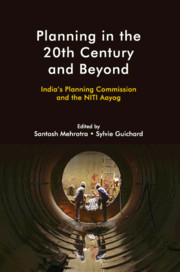Book contents
- Frontmatter
- Contents
- List of Figures
- List of Tables
- List of Abbreviations
- 1 Planning for a 21st Century India
- Part I Origins: Ideas and Ideology
- 2 From Economists to Historians: Studying the Planning Commission, 1950–2014
- 3 The Long Road to Indian Economic Planning (until 1950)
- 4 Ideas and Origins of the Planning Commission in India
- Part II Changes and Continuity: Development and Adaptation of Planning and the Planning Commission
- 5 The Planning Commission and Education
- 6 Addressing Agrarian Distress: Sops versus Development
- 7 Economic Planning after Economic Liberalization: Between Planning Commission and Think Tank NITI, 1991–2015
- 8 Planning Commission: Obiter Dictum
- 9 On a Revived Planning Commission
- Part III Planning Beyond the Planning Commission
- 10 Make in India
- 11 Manufacturing: The Cornerstone of a Planning Strategy for the 21st Century
- 12 Fiscal Planning to Sustain Growth and Poverty Reduction
- 13 Plan, but Do Not Over-plan: Lessons for NITI Aayog
- 14 Why Does India Need a Central Planning Institution in the 21st Century?
- Notes on Contributors
- Index
- References
1 - Planning for a 21st Century India
Published online by Cambridge University Press: 04 April 2020
- Frontmatter
- Contents
- List of Figures
- List of Tables
- List of Abbreviations
- 1 Planning for a 21st Century India
- Part I Origins: Ideas and Ideology
- 2 From Economists to Historians: Studying the Planning Commission, 1950–2014
- 3 The Long Road to Indian Economic Planning (until 1950)
- 4 Ideas and Origins of the Planning Commission in India
- Part II Changes and Continuity: Development and Adaptation of Planning and the Planning Commission
- 5 The Planning Commission and Education
- 6 Addressing Agrarian Distress: Sops versus Development
- 7 Economic Planning after Economic Liberalization: Between Planning Commission and Think Tank NITI, 1991–2015
- 8 Planning Commission: Obiter Dictum
- 9 On a Revived Planning Commission
- Part III Planning Beyond the Planning Commission
- 10 Make in India
- 11 Manufacturing: The Cornerstone of a Planning Strategy for the 21st Century
- 12 Fiscal Planning to Sustain Growth and Poverty Reduction
- 13 Plan, but Do Not Over-plan: Lessons for NITI Aayog
- 14 Why Does India Need a Central Planning Institution in the 21st Century?
- Notes on Contributors
- Index
- References
Summary
In his Independence Day speech on 15 August 2014, Prime Minister Narendra Modi announced the demise of the Planning Commission (PC). A reader unfamiliar with Indian politics could be surprised to learn that the PC still existed rather than that it would be terminated.
Researchers often assume that institutions never die; they find a new mission. This was true for a long time about the PC. Founded in 1950 inspired by the socialist leaning views of Jawaharlal Nehru, the successive governments in the 1960s, 1970s, and 1980s continued working with it. In 1991, when the liberalization of the Indian economy began, the PC was not dissolved. In its own words, it ‘respond[ed] and adjust[ed] to the changes quickly and creatively’ (PC 1992: 1). Some analysts considered that the commission then moved from directive planning to prescriptive planning. However, criticism was growing. The commission was said, among other things, to be inefficient, to be a vestige of the Soviet style planning, and to propose always another version of the same plan.
The PC represents an interesting case of an institution that has survived radical changes (the liberalization of the economy) and whose end came suddenly, signalled in a few sentences. Shiv Visvanathan remarked in The Hindu on 26 August 2014 that
Mr. Modi dismissed and dispensed with the institution without a footnote of thanks. There was a sadness to his rank indifference. But politics cannot dismiss history. Planning was once a great idea, a wonderful fable of the dreams, even the arrogance of knowledge. It was a great experiment which became erratic, but its history, its genius, its innovations need to be told and told fully.
The PC occupies indeed an important place in the history of India and Indian development. Scholars agree that it played a crucial role in the type of development that India followed after independence. However, even if most economic analyses of India mention the five-year plans (FYPs), the PC as an institution remains little studied.
This is why this book proposes to look backwards, examining the history of the idea of planning and the history and experiences of planning in India. It also looks forward, trying to evaluate, beyond ideologies, what role the practice of planning has and should have in contemporary India.
- Type
- Chapter
- Information
- Planning in the 20th Century and BeyondIndia's Planning Commission and the NITI Aayog, pp. 1 - 20Publisher: Cambridge University PressPrint publication year: 2020
References
- 1
- Cited by



